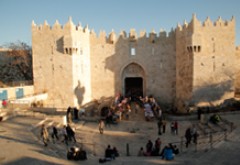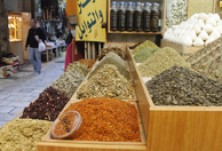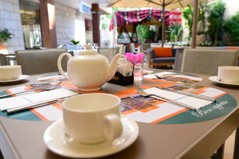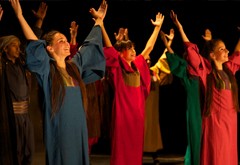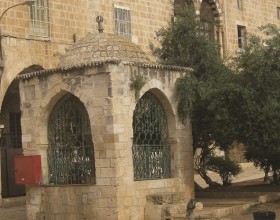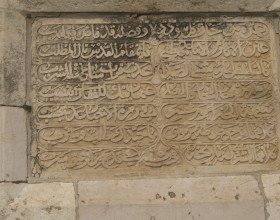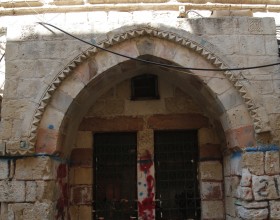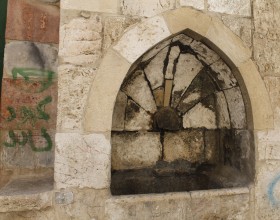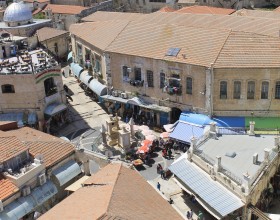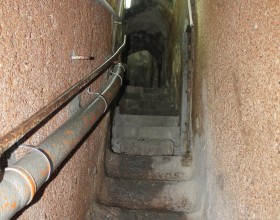Paths And Trails
Water Fountains and Troughs
Throughout its history, Jerusalem never faced a challenge more serious than the provision of water for its inhabitants. The only spring in the city is barely sufficient to fulfill a fraction of its requirements, and hence, the provision of water to the city has become a measure of the authority's ability and power, as well as the size of the city.
Trail’s Nature and Stations
The objective of this trail is to identify the importance of water in general in public life, and the water problem in the city of Jerusalem, in addition to identifying a group of water structures from various eras and of numerous designs. The full trail is inside the Old City; it is fairly easy and has no specific requirements, except decency and quietness while visiting al-Aqsa Mosque water fountains and other sites. Like other trails, the visitor can start according to the proposed arrangement or incorporate this trail with other Old City trails, which cross it at certain sites. Sites in this trail may be reversed, whereby the visitor can start at station 1 or at station 11. If the intention is to finish in the middle of the Old City, near al-Dabbagha (Tanners’ Market) and the Church of the Holy Sepulcher, then the proposed direction should be followed. If the visitor prefers to stay within al-Aqsa Mosque vicinity, it is preferable that the direction is reversed. In fact, the Old City does not form an obstacle to changing proposed trail stations, since it is small in area and provides visitors with an unlimited variety of choices.
This trail on water wells,fountains and drinking sources is composed of the following sites:
1- Sabil al-Shurbaji
2- Sisters of Zion Monastery Pool (Struthion)
3- Sabil Ibrahim al-Roumi
4- Sabil Mustafa Agha
5- Sabil Qaytbay
6- Sabil Qasim Pasha
7- Sabil Bab l-Silsila
8- Sabil al-Khalidi
9- Basin of Barka Khan Mausoleum (Al-Khalidiyya Library)
10- Suq Aftimos Fountain
11- Helena’sWell
Introduction
Status of Water in Islamic Religious Tradition
Water was mentioned in the Quran over 63 times as a basic element of existence, a blessing from Allah (God) to people, and the basis of every living organism. The Prophet’s teachings encouraged the preservation of water, even if ‘man is filling from a running river.’ Furthermore, the Prophet’s sayings and actions connected saving water and benevolence, and hence, charity is related to the construction of fountains, canals, troughs, drinking fountains and other water structures. Due to the use of water to fulfill purity requirements (ablution) and its use in many rituals among most religions, including pagan beliefs, water has gained a religious importance, in addition to its absolute necessity for the continuation of life and daily use.
Importance and Sources of Water in Jerusalem
The importance of water in Jerusalem increased for two reasons: the first is water scarcity in the Old City and its nucleus, which has no rivers or springs with the exception of the Silwan spring, whose water isdistastful. The second is that due to the holiness of the City and the arrival of many pilgrims and visitors throughout the year, pure water had to be brought in for drinking and cleanliness purposes to the City’s residents and religious institutions, including churches,mosques and synagogues. The result of these factors was reliance on rainwater and the construction of various water structures, including fountains, canals, pools, cisterns, and wells. Although rainfall levels in Jerusalem are equivalent to those in London, they are insufficient for the city’s needs, which required a search for alternative, nearby sources. Water is currently being piped from areas like Ertas and ‘Arrub through a number of canals, the most prominent of which is known as Qanat al-Sabil.
Providing Water for al-Aqsa Mosque
Being a prominent Islamic religious site and the venue for al-Isra and al-Mi’raj (The Prophet Mohammad’s ascension to heaven), al-Aqsa Mosque has attracted and continues to attract a large number of visitors from all over the Muslim world in general and Palestine in particular, especially during the Holy month of Ramadan and other religious occasions. The Islamic authority hence had to provide water for people to perform their religious rituals. Attention to water wells and the provision of water to al-Aqsa Mosque area has demanded attention since the Umayyad era and until today.
Water structures have been distributed according to a well-studied methodology, reflecting the entry and exit movement of the City’s residents and site visitors. The water system is meant to provide clean, drinkable water to pedestrians, as part of the religious connotation of water. Drinking fountains were wisely located in main Jerusalem streets as well as al-Aqsa Mosque, such as Bab al-Khalil (Jaffa Gate) fountain, Bab al-Asbat (St. Stephan Gate) fountain, and numerous other fountains in neighborhoods and streets, such as Bab al-Nazir , Bab al-Silsila, al-Wad, and other balanced locations in al-Aqsa Mosque vicinity.
Jerusalem Pools
Jerusalem used to have a number of pools inside the Old City or along its periphery, including al-Sultan (Barquq), Jorat al-‘Innab, Sisters of Zion Monastery (Struthion), Mamilla (Ma’man Allah), al-Khanqa al-Salahiyya (the Patriarch’s Bath), Sittna Maryam (St. Mary), Salahiyya School (Bait Hasda), Helena’s Pool near the Coptic Monastery, as well as Sultan Suleiman’s Pool near the village of Ertas, near Bethlehem. It is noteworthy that each house in the Holy City used to have one or more rainwater collection wells.
Drinking and Other Fountains
Before embarking on examining the Sabils (Fountains) and Troughs Trail stations, it must be mentioned that a drinking fountain is a small trough attached to an architectural unit, such as a cemetery, a madrasa (school), or a zawiya, in order to provide drinking water for pedestrians and gain recompense. The fountain is normally either separate or part of another structure such as a mosque or school. If the fountain is in close proximity to a religious site or is part of it, then it was also used for ablution and purification.

